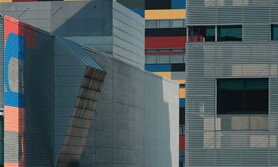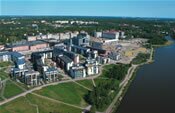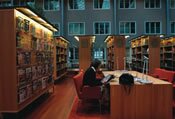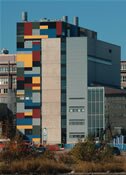Inflight Magazine of Brussels Airlines
Welcome to the Inflight Magazine of Brussels Airlines
High concept Helsinki
Finland ma y have arrived late to the industrialisation era, but as Helsinki’s late st redevelopment shows, in the space o f two decades it’s made giant strides forward. Evgenia Ivano va plays catch-up
 Last year the World Economic Forum’s Global Competitiveness Report studied 131 countries. And who did they place first in terms of innovation? Finland. And countervailing proof that they made the right decision, should such proof be needed, comes in the form of Helsinki’s latest regeneration project: Arabianranta.
Last year the World Economic Forum’s Global Competitiveness Report studied 131 countries. And who did they place first in terms of innovation? Finland. And countervailing proof that they made the right decision, should such proof be needed, comes in the form of Helsinki’s latest regeneration project: Arabianranta.
Located on the shore of the old Helsinki bay, Arabianranta is the oldest part of Helsinki. Site of the original city, founded by King Gustav Wasa some 500 years ago, it’s also home to the famous Arabia pottery factory. Once the biggest in Europe, this is the operation that kick-started the region’s industrialisation in 1874.
It seems fitting that Helsinki’s most forward-looking development should be grafted onto a district with such a progressive reputation. And the city is certainly ready for it. Although the project isn’t slated for completion until 2010, there are already 4,000 new residents living in Arabianranta. Many of them are employees of the 300 companies based there – mostly design and media agencies, including Finnish design pioneer Hackman Oyj. And the residential contingent is set to swell, as increasing numbers of employees who live outside the area are showing serious interest in moving.
It’s often said that success in Finnish business can largely be attributed to the skill with which all parties cooperate and their staunch commitment to reach the common goal. Arabianranta is a case in point. In 1999 the National Ministry of Trade and Industry teamed up with the University of Art and Design and a clutch of local landowners and property developers, a group which has managed the project on a collaborative basis. That’s not to say the development has progressed without a hitch. The construction of 300,000m2 of flats and 200,000m2 of new university, office and commercial space could only begin in 2000, after the government purged the surrounding soil from heavy metals, oil and various by-products from the pottery factory.
 But the most extraordinary prerequisite the district had to fulfil came in the form of an unprecedented condition set by the government: in order to render the area attractive to potential residents, developers were obliged to spend a relatively hefty chunk of their budget on art and design. As the development’s arts coordinator, Dr Tuula Isohanni, notes, this reciprocal arrangement saw the government offset the money it had already sunk into the ground against the area’s great potential for artistic growth.
But the most extraordinary prerequisite the district had to fulfil came in the form of an unprecedented condition set by the government: in order to render the area attractive to potential residents, developers were obliged to spend a relatively hefty chunk of their budget on art and design. As the development’s arts coordinator, Dr Tuula Isohanni, notes, this reciprocal arrangement saw the government offset the money it had already sunk into the ground against the area’s great potential for artistic growth.
“Because the city had invested over €40m in the soil here, and because construction companies then got clean, stabilised ground to build on, the city decided that the building companies had to invest 1-2% of construction costs in artistic collaboration in this area.”
At present, the Arabianranta community is living alongside more than 70 pieces of art. If all goes to plan, 1,000 pieces of work by 200 artists will be on display in 2010.
Finns believe that true art should be functional as well as beautiful, and sit comfortably alongside modern technology. Accordingly, much of the art at Arabianranta is based around research into residents’ needs. Take Raija Siikamäki and Ulla Pohjola’s work for the Brunow and Maunula-designed residential block. Taking a study on recycled glass as her starting point, Raija Siikamäki created a piece made with melted elements from monitors and televisions that lights up the inner courtyard. Meanwhile, Ulla Pohjola’s ‘Light Stone’ tiles, with which the courtyard is FR Haute technologie à Helsinki
 L’année dernière, le Rapport du Forum Economique Mondial sur la Compétitivité Globale a passé en revue la situation de 131 pays. Et qui ont-ils placés en tête en matière d’innovation? La Finlande. A juste titre, le dernier projet de régénération urbaine d’Helsinki, Arabianranta, est la preuve indubitable que le FEM a fait le bon choix.
L’année dernière, le Rapport du Forum Economique Mondial sur la Compétitivité Globale a passé en revue la situation de 131 pays. Et qui ont-ils placés en tête en matière d’innovation? La Finlande. A juste titre, le dernier projet de régénération urbaine d’Helsinki, Arabianranta, est la preuve indubitable que le FEM a fait le bon choix.
Situé sur le rivage de la vieille baie d’ Helsinki, Arabianranta est la plus ancienne partie de la ville, qui héberge également l’usine de poterie Arabia, un facteur de dynamisation de l’industrialisation de la région en 1874. Il est intéressant d’ailleurs de noter que le projet de transformation urbaine le plus évolué d’ Helsinki se soit implanté dans une zone bénéficiant déjà d’une réputation progressiste.
La ville est certainement prête pour ce grand saut. Bien que la mise en place définitive du projet ne soit pas prévue avant 2010, on trouve déjà 4 000 nouveaux résidents installés à Arabianranta. Par eux, de nombreux employés des 300 compagnies basées dans le coin.
Le développement a démarré en 2000 après que le gouvernement ait assaini les sols environnants, en les débarrassant des métaux lourds et des produits issus de l’activité de l’industrie de la poterie, pour un budget de l’ordre de €40 millions. Cette revitalisation du lieu est allée de pair avec une condition sans précédent, destinée aux promoteurs : pour rendre ce quartier attrayant aux nouveaux résidents, les entrepreneurs ont dû dépenser entre 1 et 2% de leur budget dans l’art et le design. Aujourd’hui, la communauté d’Arabianranta dispose de plus de 70 oeuvres d’art. D’ici 2010, plus de 1 000 pièces devraient être exposées.
Helsinki a toujours penché en faveur des hautes technologies. C’est ainsi que la population d’Arabianranta sera reliée par le réseau du Village Virtuel d’Helsinki, une infrastructure sans fil accessible via les téléphones mobiles, les organiseurs, la télévision digitale et les ordinateurs personnels. Le développement intègre aussi un Living Lab (laboratoire vivant) – comme à Stockholm, Copenhague, Barcelone et Amsterdam, une unité de recherche scientifique basée sur l’ observation de la population.
Les prévisions tablent en 2010 sur une communauté de 10 000 résidents et de 6 000 étudiants, avec la création de 8 000 jobs à la clé. Au vu de la vitesse d’évolution du quartier, ces objectifs seront plus que probablement atteints.
paved, are striated with delicate veins of light, illuminating the space and creating clearly lit pathways. In tandem, the pieces form reflections on the courtyard’s surfaces; patterns of light that can be seen from the windows of the apartments above.
 Helsinki’s got a reputation for embracing the high tech, and Arabianranta’s no exception. The project’s population (which will include students, workers and residents based here) will be linked by the Helsinki Virtual Village network, a wireless infrastructure accessible through mobile phones, PDAs, digital televisions and personal computers, which incorporates a 10Mb broadband connection. But the HVV portal will not only be used as a resource for residents and local companies – it will also work as a tool for the development and marketing of the district.
Helsinki’s got a reputation for embracing the high tech, and Arabianranta’s no exception. The project’s population (which will include students, workers and residents based here) will be linked by the Helsinki Virtual Village network, a wireless infrastructure accessible through mobile phones, PDAs, digital televisions and personal computers, which incorporates a 10Mb broadband connection. But the HVV portal will not only be used as a resource for residents and local companies – it will also work as a tool for the development and marketing of the district.
Then there’s Arabianranta’s status as a Living Lab. The concept of a Living Lab, an area where scientists observe people in a ‘real life’ setting, in order to find solutions to the new challenges that a rapidly changing environment continually throws up, is one that’s quickly gaining currency all over Europe. And along with cities like Stockholm, Copenhagen, Barcelona and Amsterdam, Helsinki is considered one of the most important Living Labs on the continent. Already nearly 20 different projects have been implemented in the area – both short-term schemes with a regional remit, and long-term developments carried out all over Europe – all using the HVV portal as a research instrument.
The project’s nothing if not ambitious. It’s hoped that by 2010, the community will house 10,000 residents and 6,000 students, creating 8,000 jobs in the process.
And going by the speed with which the district has developed, and the enthusiasm with which it’s been greeted, it’s not all that unlikely it will hit these targets. As Kari Halinen, chief executive officer at Art and Design City Helsinki Ltd, the company that’s spearheaded the Arabianranta development points out: “Last millennium, Helsinki Virtual Village was merely a vision, a desire for a new, better, bigger lifestyle.
The goal was to make Arabianranta the leading centre of art and design in the Baltic area. Now [it’s] become a reality.”
NL High concept Helsinki
Vorig jaar nam het World Economic Forum met het Global Competitiveness Report 131 landen onder de loep. In het domein van de innovaties scoorde Finland de hoogste cijfers. En dat het land die eerste plaats dubbel en dik verdient, bewijst Helsinki’s nieuwste regeneratieproject Arabianranta.
Arabianranta ligt op de kust van de oude baai van Helsinki en is het oudste deel van de stad. Het is ook de thuishaven van de aardewerkfabriek Arabia, die het startschot gaf voor de industrialisering van de streek in 1874. Het lijkt geen toeval dat Helsinki’s meest vooruitstrevende bouwproject een plek met zo’n progressieve reputatie heeft uitgekozen.
De stad is er alvast klaar voor. Hoewel het project niet voor 2010 voltooid zal zijn, telt Arabianranta al 4.000 nieuwe bewoners. Velen daarvan werken in een van de 300 bedrijven die er gevestigd zijn.
Het bouwproject ging van start in 2000, nadat de overheid de omliggende bodem had ontdaan van zware metalen, olie en diverse bijproducten van de aardewerkfabriek. Het prijskaartje: 40 miljoen euro. Ze stelde wel één ongewone voorwaarde: om het gebied aantrekkelijk te maken voor potentiële bewoners moeten ontwikkelaars 1-2% van hun budget uitgeven aan kunst en design. De gemeenschap van Arabianranta herbergt ondertussen al 70 kunstwerken. Tegen 2010 zouden dat er 1.000 moeten zijn.
Helsinki heeft hightech altijd al in haar armen gesloten. De bevolking van Arabianranta wordt dan ook met elkaar verbonden via het Helsinki Virtual Village-netwerk, een draadloze infrastructuur die toegankelijk is via gsm’s, pda’s, digitale tv’s en pc’s. Het bouwproject doet ook dienst als Living Lab. Wetenschappers uit Stockholm, Kopenhagen, Barcelona en Amsterdam baseren hun onderzoek immers op observaties van de bevolking hier.
Gehoopt wordt dat de gemeenschap tegen 2010 plaats zal bieden aan
10.000 inwoners en 6.000 studenten, en 8.000 jobs zal creëren. Te oordelen aan de snelheid waarmee het gebied zich al heeft ontwikkeld, zou dat wel eens kunnen lukken!
Leave a Reply
